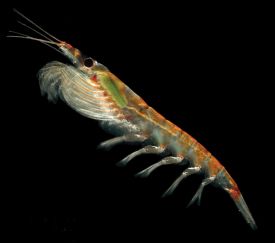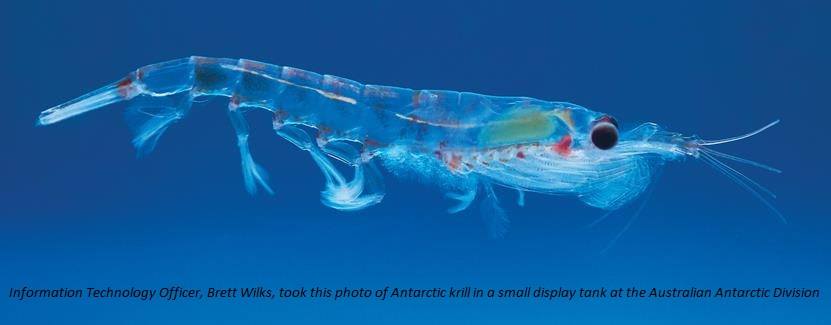
What’s a ‘Krill’?
Well for starters it’s a Norwegian word meaning “small fry of fish” but in reality ‘Krill’ is a general term used to describe about 85 species of free-swimming, open-ocean crustaceans.
Antarctic krill will be the one you hear about on the news and it’s one of these species living in the southern oceans. It basically looks like a prawn and is about 6 cm long.
Krill may constitute the largest multicellular animal biomass on the planet with the amount of Antarctic krill in the Southern Ocean estimated to be 500 million tonnes.
Sometimes their schools or swarms can stretch for kilometres and colour the ocean red but they usually only rise to the surface at night.
Female Antarctic krill are very fertile and productive, laying up to 10,000 eggs at a time, and sometimes several times in a season.
They feed mainly on microscopic suspended plants (phytoplankton) and sometimes on tiny marine animals (zooplankton).
In winter they will eat algae growing on the underside of the ice pack, discarded waste matter on the sea-floor or other tiny animals in the water but they can survive without food for periods of up to 200 days.
Seals, whales, fish, squid and seabirds all depend on Krill to a greater or lesser extent so they are an extremely important resource in the food chain.
Thanks to the Convention on the Conservation of Antarctic Marine Living Resources (CCAMLR) there are limits on the amount of krill that can be caught and it takes into account the needs of other elements of the ecosystem (meaning the other animals that feed on them).
It was found recently that krill can consume microplastics and break them down into much smaller nanoplastics. The impact and significance of this are still being investigated.
Australians Scientists at the Australian Antarctic Division lead the world in the study of krill with the goal of better management and protection of this extremely important part of the Antarctic food chain. They’re doing great work.

KRILL – A LONG WAY FROM THEIR ANTARCTIC HOME.
Krill, a small shrimp, is the basis of the Antarctic food chain. They occur in huge numbers in the seas of Antarctica and understanding them is important for the future preservation of Antarctic wildlife, from fish to whales.
There are only two Krill aquariums in the world and one of those is a public aquarium in Japan. The other is the Australian Antarctic Division’s Krill Aquarium in Hobart.
There, they raise krill from egg to adult, a total of 12 larval stages, and can observe their natural behaviour. Besides these home-grown krill the facility bring in 20,000 wild krill each year to enhance their knowledge of krill biology.
Krill tend to be very social animals but in captivity they are more likely to act individually. However, in 2005 the facility managed to achieve repeated krill schooling behaviour in captivity which means that they are acting as they normally would in the wild. This means that we can now observe their natural behaviour in response to external stimulus. This information is then used in modelling for fisheries research and to expand our understanding of their interactions with predators.
One finding of the research is that krill swim horizontally when schooling and more vertically when feeding. This results in different echo sounder readings but current experiments at the aquarium using different echo sounder frequencies while imaging krill orientation will eventually result in more accurate measurements of krill density which will be important for fishery management and sustainable catches.
Other findings are that krill live for 5-6 years rather than the 3-4 years that was the conventional wisdom. There is virtually no difference in the size of krill past two years of age so it is difficult to age them but the researchers at the AAD have found that krill can be aged using annual growth bands in their eye stalks.
They also shrink in the absence of food which may seem obvious but where you and I will lose fat the krill’s body actually shrinks within their exoskeleton.
Our oceans absorb large amounts of CO2. As CO2 increases chemical reactions in seawater cause an increase in acidity and krill egg hatching rates decrease as acidity levels rise. Researchers have been able to construct risk maps to show the areas that will be most likely affected in the future. They have also produced a detailed catalogue of krill genes to assist future research.
One fascinating aspect of their research is that krill are able to digest microplastics and break them down into even smaller sizes (78-94% of the original material) and the resulting pieces are known as nanoplastics.
This process has never been observed before in any other crustacean. What the implications of this for the environment are not yet known but it certainly doesn’t sound good to have even smaller pieces of plastic out there.
I didn’t get the opportunity to see the aquarium up close when I visited this year because it is in a quarantined area but the AAD is doing cutting edge research which will have implications for the future health of krill populations. Well done AAD.
THE COST OF KRILL OIL
Krill are a a tiny, shrimp-like animal. Baleen whales, mantas, and whale sharks eat primarily krill but so do penguins, seals, squid and fish. It is the most important base of the Antarctic food chain. For some background on krill see my earlier post https://bit.ly/2Oaq6Ox
Krill oil is one of the more recent additions to the supplement market, gaining popularity due to its Omega 3 content, and is currently sold by a small group of companies such as Aker Biomarine, RIMFROST, Pesca Chile, China National Fisheries Corporation and so on.
Krill oil contains fatty acids similar to fish oil and it is most commonly used for heart disease, high levels of certain blood fats (triglycerides), and high cholesterol, but there is limited scientific research to support these uses.
The increasing demand for krill oil has created a problem of overfishing of krill in the Antarctic Ocean. Although, an estimated 1% of the Antarctickrill is catchable, there is no specified zone and hence some areas are worse off than the others.
The krill found in the areas surrounding South Georgia Island and Elephant Island are a favourite area for krill harvesting because of their remoteness and lack of pollutants.
In a suitable response, companies around the globe have agreed to close off a zone covering 1.5 million square kilometers around Antarctica. The move is not yet implemented as acceptance from more organizations is required.
Since 2010, the krill-fishing industry has grown steadily, with the entry of Norwegian companies and fishing boats, increased catches by South Korean vessels, and the emergence of the Chinese krill-fishing fleet.
Antarctica is a long way away and out of sight of inspection so they are getting closer and closer to protected areas. With global warming and a growing krill industry, the krill face a double threat. With so many animals relying on krill to live the best way to slow down this industry is to not buykrill oil.
I gave it up some time back because you can get omega 3’s from most fish (even a can of tuna), beef, chicken, lamb, butter and cheese and from the plant world, nuts and various vegetable oils (especially flax seed oil) will give you all the Omega 3’s you need.
So do the world a favour and give krill oil a miss.

